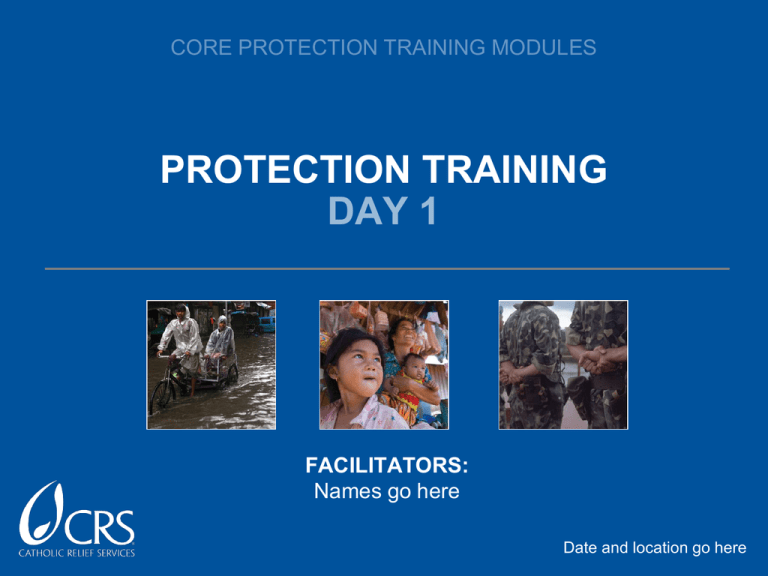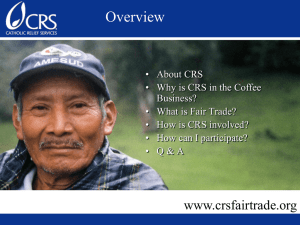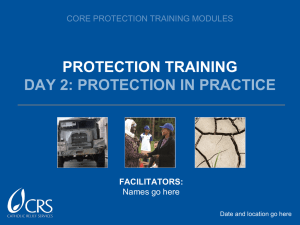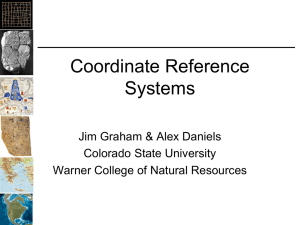CRS Protection Training Module
advertisement

CORE PROTECTION TRAINING MODULES PROTECTION TRAINING DAY 1 FACILITATORS: Names go here Date and location go here TRAINING OUTLINE DAY ONE 09:00 - 10:30 Welcome and introductions Defining protection 10:30 - 11:00 Break 11:15 - 12:40 A CRS holistic approach to protection 12:40 - 1:40 Lunch 1:40 - 3:20 The legal framework 3:20 - 3:40 Break 3:40 - 5:00 Protection actors CRS Core Protection Training Modules 2 LEARNING OBJECTIVES Define humanitarian protection; Articulate why protection is a priority for CRS; Articulate CRS’s foundations for engaging in protection, starting with CST; Establish linkages and complementarities between CRS principles and protection; CRS Core Protection Training Modules 3 LEARNING OBJECTIVES Identify international legal standards and principles for humanitarian protection; Outline the roles and responsibilities of the key players in protection; Identify cross-cutting themes in protection; Demonstrate an understanding of the importance of accountability to our beneficiaries. CRS Core Protection Training Modules 4 DEFINING PROTECTION CRS Core Protection Training Modules 5 CRS AND PROTECTION It’s part of the 2007 – 2010 Emergency Strategy Excerpt: “further explore and expand our role in protection in order to improve the balance on that side of the humanitarian action (assistance and protection) equation.” CRS Core Protection Training Modules 6 CRS Core Protection Training Modules What is protection? Who needs protection? From what? By whom? 7 DEFINING PROTECTION ICRC Definition “all activities aimed at ensuring full respect for the rights of the individual in accordance with the letter and the spirit of the relevant bodies of law i.e. human rights law, international humanitarian law, refugee law.” CRS Core Protection Training Modules 8 DEFINING PROTECTION “Assistance and protection are the two indivisable pillars of humanitarian action.” From: The Sphere Handbook CRS Core Protection Training Modules 9 Protection is not just an academic concept CRS Core Protection Training Modules 10 QUESTIONS? CRS Core Protection Training Modules 11 A CRS HOLISTIC APPROACH TO PROTECTION CRS Core Protection Training Modules 12 DEFINING PROTECTION – A HOLISTIC APPROACH Safety Dignity/Freedom Integrity Empowerment Rights-based CRS Core Protection Training Modules 13 PRINCIPLES OF JUSTICE FROM CST The dignity and equality of the human person Rights and responsibilities The common good Solidarity Preferential option for the poor Subsidiarity and stewardship CRS Core Protection Training Modules 14 PRINCIPLES OF HUMAN RIGHTS Human rights are founded on the respect for dignity of each person. Human rights are universal Human rights are inalienable Human rights are indivisible, interrelated and interdependent CRS Core Protection Training Modules 15 QUESTIONS? CRS Core Protection Training Modules 16 THE LEGAL FRAMEWORK CRS Core Protection Training Modules 17 WHO IS PROTECTED BY LAW? Civilian men, women, and children People who are not taking an active part in conflicts (non-combatants) Refugees Internally displaced persons (IDPs) Humanitarian workers Religious personnel CRS Core Protection Training Modules 18 A LEGAL FRAMEWORK FOR HUMAN RIGHTS International Human Rights Law International Humanitarian Law International Refugee Law National Constitutions and national law CRS Core Protection Training Modules 19 LEGAL RESPONSIBILITIES For every right… …there is a corresponding duty CRS Core Protection Training Modules 20 WHAT ARE HUMAN RIGHTS? “Human rights are legitimate claims for the minimum civil, cultural, economic, political, and social needs that every human being has a right to enjoy because they are human.” CRS Core Protection Training Modules 21 GENERATIONAL HUMAN RIGHTS First Generation Rights Civil, Legal and Political Rights Second Generation Rights Economic, Social and Cultural Rights Third Generation Rights Collective Rights, Right to Development, Environmental Rights. CRS Core Protection Training Modules 22 SOURCES OF INTERNATIONAL HUMAN RIGHTS LAW Universal Declaration of Human Rights (UDHR) International Covenant on Economic, Social and Cultural Rights (ICESCR) International Covenant on Civil and Political Rights (ICCPR) Convention on the Elimination of all forms of Discrimination Against Women (CEDAW) Convention on the Rights of the Child (CRC) CRS Core Protection Training Modules 23 SCOPE OF INTERNATIONAL HUMAN RIGHTS LAW Apply everywhere all the time (in times of peace and conflict) Impose duties on states to uphold, promote and fulfill the rights of citizens CRS Core Protection Training Modules 24 QUIZ! CRS Core Protection Training Modules 25 INTERNATIONAL HUMANITARIAN LAW Or the “Laws of War” CRS Core Protection Training Modules 26 INTERNATIONAL HUMANITARIAN LAW IHL is a set of rules seeking, for humanitarian reasons, to limit the effects of armed conflict. IHL protects persons who are no or are no longer participating in the hostilities. IHL restricts the means and methods of warfare. CRS Core Protection Training Modules 27 SOURCES OF INTERNATIONAL HUMANITARIAN LAW Four Geneva Conventions Article 3, common to all of the conventions, refers to internal armed conflicts [ ‘a mini convention’] Two Additional Protocols CRS Core Protection Training Modules 28 INTERNATIONAL HUMANITARIAN LAW PROTECTS... Those who are not, or no longer, taking part in fighting (non-combatants) IHL prohibits all means and methods of warfare which: fail to discriminate between combatants and non combatants cause unnecessary injury or suffering cause severe or long-term damage to the environment CRS Core Protection Training Modules 29 SCOPE OF INTERNATIONAL HUMANITARIAN LAW Applies in times of conflict …but not in peace times Imposes duties on states and warring parties CRS Core Protection Training Modules 30 INTERNATIONAL REFUGEE LAW CRS Core Protection Training Modules 31 WHO IS A REFUGEE? “Any person who owing to well founded fear of being persecuted for reasons of race, religion, nationality, membership of a particular social group or political opinion, is outside the country of his nationality and is unable or, owing to such fear, is unwilling to avail himself of the protection of that country, or who, not having a nationality and being outside the country of his former habitual residence, is unable or, owing to such fear, is unwilling to return to it”. 1951 Convention on the Status of Refugees CRS Core Protection Training Modules 32 THE PRINCIPLE OF NON-REFOULEMENT A refugee has a right to be protected against forcible return. Art .33 (1) “…no refugee shall be sent (back) to a country in which his or her life or freedom would be threatened on account of race, religion, nationality, membership of a particular social group or political opinion; or where there are substantial grounds for believing that s/he would be in danger of being exposed to torture” The prohibition of refoulement is part of international customary law. CRS Core Protection Training Modules 33 THE RIGHT TO SEEK ASYLUM Art.14 (1) UDHR “Everyone has the right to seek and enjoy in other countries asylum from persecution” Asylum means basic protection for a temporary period, with the possibility of staying in the host country until a solution outside that country can be found. CRS Core Protection Training Modules 34 SOURCES OF REFUGEE LAW The instruments include: the 1951 United Nations Convention Relating to the Status of Refugees modified by the 1967 Protocol Relating to the Status of Refugees, the 1969 OAU Convention Governing the Specific Aspects of Refugee Problems in Africa the 1984 Cartagena Declaration on Refugees for Latin America CRS Core Protection Training Modules 35 WHO IS AN IDP? “IDPs are defined as those persons forced or obliged to flee from their homes, “…in particular as a result of or in order to avoid the effects of armed conflicts, situations of generalized violence, violations of human rights or natural or human-made disasters, and who have not crossed an international recognized State border” IDP Guiding Principles, 1998 CRS Core Protection Training Modules 36 DO IDPS HAVE SPECIFIC RIGHTS? IDPs shall enjoy, in full equality, the same rights and freedoms under international and domestic law as do other persons in their country. IDPs should not be discriminated against in the enjoyment of any rights and freedoms on the ground that they are internally displaced. CRS Core Protection Training Modules 37 THE GUIDING PRINCIPLES FOR IDPS Framework to guide anyone working with IDPs Is not legally binding, but analogous with refugee law Rights of the displaced Obligations of national authorities Obligations of international authorities CRS Core Protection Training Modules 38 REFUGEE? …crossed an international state border? …moved to another country in order to get a better job? …fled and crossed an international state border owing to persecution for political beliefs? …fled owing to a natural disaster? …fled while still a member of the armed services? …fled having committed a serious crime? CRS Core Protection Training Modules 39 IDP? …moved to another country in order to get a better job? …fled but remained in their own country owing to persecution for political beliefs? …fled but remained in their own country owing to a natural disaster? …been forcibly moved by the state for their own safety? CRS Core Protection Training Modules 40 WHY CLASSIFY IDPS? As a result of their displacement IDPs may have additional vulnerabilities, such as loss of livelihood and security of food. CRS Core Protection Training Modules 41 PROTECTION NEEDS RELATED TO SPECIFIC VULNERABLE GROUPS Gender (SGBV) Age (children, adolescents, elderly) Diversity (ethnic minorities) Disabilities (physical, mental) Health (HIV/AIDS) CRS Core Protection Training Modules 42 THE LEGAL INSTRUMENTS QUIZ Human Rights Law Example of The International Bill of Documentary Rights Source The right to life with Core Ideas dignity Who has rights? Everyone States (legally) but Who has duties? everyone’s (morally) Most apply always, some When do they don’t in states of apply? emergency CRS Core Protection Training Modules Humanitarian Law Refugee Law The Geneva Conventions The Convention on the Status of Refugees The distinction b/w combatants and noncombatants Principle of non-refoulement Noncombatants in conflict Refugees, but not IDPs States and warring parties States where refugees reside In armed conflicts only Wherever refugees exist 43 QUESTIONS? CRS Core Protection Training Modules 44 PROTECTION ACTORS CRS Core Protection Training Modules 45 WHO PROTECTS: ACTOR MAP NGOs STATES HOST COMMUNITIES REGIONAL BODIES COMMUNITIES CRS Core Protection Training Modules UN AGENCIES BENEFICIARIES Protected People LOCAL PARTNERS RED CROSS AND RED CRESCENT 46 QUESTIONS? CRS Core Protection Training Modules 47







